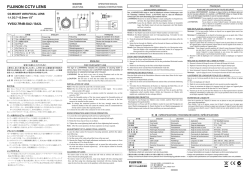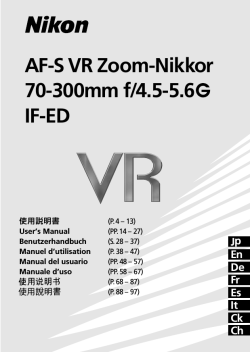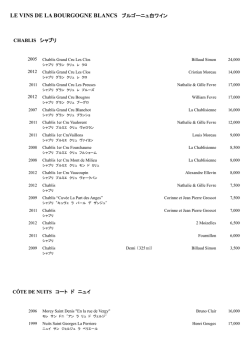
AF Nikkor 24mm f/2.8D
AF Nikkor 24mm f/2.8D 使用説明書 Instruction Manual Bedienungsanleitung Manuel d’utilisation Manual de instrucciones Manuale di istruzioni の使用説明書に記載 されている「安全上のご注意」も併せてお読みください。 付属アクセサリー Accesorios estándar 52mmスプリング式レンズキャップ 裏ぶた LF-1 Tapa frontal a presión de 52 mm Tapa trasera de objetivo LF-1 Standard accessories Accessori in dotazione 52mm snap-on front lens cap Rear lens cap LF-1 Tappo anteriore da 52mm dia. Tappo posteriore LF-1 Serienmäßiges Zubehör Aufsteckbarer Frontdeckel 52mmφ Objektivrückdeckel LF-1 52 Jp En De Fr Es It Ck Ch このレンズは、ニコンのAF[オートフォーカス(D60、D40 シリーズ、F3AFを除く)]カメラと組み合わせますと、オートフォー カス撮影が可能です。マニュアル(手動)によるピント合わせも 行えます。さらに撮影距離情報を取り入れたカメラとの組み合 わせでは、撮影距離情報をカメラに伝達する機能を備えていま す。広角レンズですので風景写真はもとより、建築写真や狭い 室内での撮影、スナップ、旅行の際の記録写真など幅広い用途 に適しています。また、遠近感が極端に誇張されますので、特 異な効果を狙った迫力のある写真が得られ、近距離補正方式に より近写性能も優れています。 ●D60、D40シリーズカメラでは、オートフォーカスが使用で きません。マニュアルフォーカスで撮影してください。 Accessoires fournis Bouchon avant d'objectif diamètre 52 mm Bouchon arrière LF-1 上記以外のアクセサリーにつきましても、カメラとの組み合わせに よりご使用できないことがあります。アクセサリーのご使用に際し ては、必ず各カメラの使用説明書も併せてご参照ください。 ニコンF6、F5、F4、F3シリーズカメラには多種類のファイン ダースクリーンが用意されています。レンズのタイプや撮影条件に 合わせて、最適なものを選ぶことができます。このレンズに適した ファインダースクリーンは裏の表の通りです。 (なお、ご使用に際しては必ず各カメラの使用説明書を併せてご参 照ください。) 52mmネジ込み式フィルター レンズ表面の汚れや傷を防ぐために、NCフィルターの使用をおす すめします。レンズの保護には、フードも役立ちますのでご使用 ください。 52mmネジ込みフードHN-1 カメラへの撮影距離情報出力可能 CPU・AI方式のカメラでは開放測光 従来方式のカメラでは絞り込み測光 約64.5(最大径)×46mm(長さ:バヨネットマウン ト基準面からレンズ先端まで)、全長約55.5mm 質量: ● 仕様、外観の一部を、改善のため予告なく変更することがあ ります。 52 •Autofocus is not possible with Nikon’s D60 and D40-Series cameras. When using the lens with these models, set camera focus mode to M. 使用説明書の内容が破損などによって判読できなくなったときは、ニコンサービス機関にて新しい使用説明書をお求めください(有料)。 No reproduction in any form of this manual, in whole or in part (except for brief quotation in critical articles or reviews), may be made without written authorization from NIKON CORPORATION. NIKON CORPORATION Specifications and designs are subject to change without any notice or obligation on the part of the manufacturer. FUJI BLDG., 2-3, MARUNOUCHI 3-CHOME, CHIYODA-KU, TOKYO 100-8331, JAPAN Printed in Japan TT8C17 (80) 8MNJA125-17 ▲ •Autofokusbetrieb ist mit der Nikonkameras D60 und D40-Serie nicht möglich. Bei Verwendung des Objektivs mit diesen Modellen ist an der Kamera Fokussiermodus M zu wählen. Änderungen von technischen Daten und Design durch den Hersteller vorbehalten. •L’autofocus n’est pas possible avec les appareils photo D60 et série D40 de Nikon. Lorsque vous utilisez l’objectif avec ces modèles, réglez le mode de mise au point de l’appareil photo sur M. フォーカスリング Les caractéristiques et le dessin sont susceptibles d’être modifiés sans préavis ni obligation de la part du constructeur. •El enfoque automático no es posible con las camaras D60 y Serie D40 de Nikon. Al utilizar el objetivo con estos modelos, ajuste el modo de enfoque de la cámara a M. Las especificaciones y los diseños están sujetos a cambio sin previo aviso ni obligación por parte del fabricante. ■接写表 ■Photographic Range With Close-Up Attachments ■Fotografische Bereiche mit dem Nahaufnahme-Zubehör ■Rapports obtenus en proxiphotographie et photomacrographie ■Rangos fotográficos con accesorios de aceramiento ■Fotografia con dispositivi per riprese Close-Up (cm) •La messa a fuoco automatica non è possibile con le fotocamere D60 e Serie D40 della Nikon. Se si usa la lente con questi modelli, impostare la modalità di messa a fuoco della fotocamera su M. Le specifiche e i disegni sono soggetti a modifica senza preavviso o obblighi da parte del produttore. * ** *** * PKリングのはじめの数値はPK-11Aリング1個使用のとき、あとの数値はPK-11A∼PK-13リング、PK-11∼PK-13リングまたはPK-1∼PK-3リングを 連結したときのものです。ただし、PK-11リングおよびPK-1リングは、このレンズに直接取り付けることはできませんので、ご注意ください。 ** スライド複写装置PS-4、PS-5のレンズ逆向き時の倍率範囲は、BR-3リングまたはBR-6リングを併用したときのものです。 *** 複写装置PF-2、PF-3、PF-4は、レンズ単体で用いたとき、複写台の載物面上の撮影可能範囲を示します。 * The first values are for the PK-11A ring used alone and the other ones for the PK-11A—PK-13, PK-11—PK-13, or PK-1—PK-3 rings used together. However, the PK-11 and PK-1 rings can not be attached directly to the lens. ** The Macro Adapter Ring BR-3 or BR-6 is used to connect the reverse mounted lens to the copying adapter. *** The figures shown here represent the ranges obtained with the subject on the baseplate, using the lens without any close-up attachment. * Die ersten Werte gelten für den Zwischenring PK-11A, wenn dieser allein benutzt wird. Die anderen Werte gelten für die Kombinationen PK-11A—PK-13, PK-11—PK-13 oder PK-1—PK-3. Die Zwischenringe PK-11 und PK-1 lassen sich nicht direkt am Objektiv anbringen! ** Der Umkehrring BR-3 oder BR-6 ist zum Anschluß des Objektives in Reprostellung an den Kopieransatz. *** Die Angaben beziehen sich auf die Abstände, die entstehen, wenn das Objekt auf der Grundplatte liegt und das Objektiv nicht mit Nahaufnahmezubehör versehen ist. * Les premières valeurs sont pour la bague PK-11A utilisée seulement et les autres pour les bagues PK-11A—PK13, PK-11—PK-13 ou PK-1—PK-3 utilsees ensemble. Toutefois, les bagues PK-11 et PK-1 ne peuvent être directement fixées à l’objectif. ** La bague d’adaptateur macro BR-3 ou BR-6 sert à relier l’objectif monté à retourné l’adaptateur de reproduction. Les chiffres indiqués représentent les rapports obtenus avec le sujet sur le plateau. l’objectif étant utilisé san asccessoire macro. * Los primeros valores son para el caso en que se utilice el anillo PK-11A solo y los otros valores para el caso en que se utilicen los anillos PK-11A—PK-13, PK-11—PK-13, o PK-1—PK-3 juntos. Sin embargo, no es posible montar los anillos PK-11 y PK-1 en el objetivo en forma directa. ■ 被写界深度表 ■Depth of field ■ Schärfentiefentabelle ■ Profundidad de campo ■Profondità di campo ■ ■ Profondeur de champ ■ ■Depth of field ■ ■ ■ ■ ファインダースクリーンとの組み合わせ表 Table of Recommended Focusing Screens Tabelle der empfohlenen Einstellscheiben Tableau des verres de visée recommandés ■構図の決定やピント合わせの目的には ◎: 好適です ○: 視野の一部が多少見にくくなりますが、撮影結果 には全く影響がありません。 △ : スプリットの合致像は見えますが、ピント合わせ は精度上適しません。 ( ): 中央部重点測光時の補正値です。F6カメラの場合、 測光値の補正は、カメラのカスタムメニュー「b6 スクリーン補正」を「BorE以外」にセットして行 います。B型およびE型以外を使用する場合は、補 正量が0でも、 「BorE以外」にセットしてください。 ** El anillo macro adaptador BR-3 o BR-6 sirve para acoplar el objetivo invertivo al adaptador de reproducción. *** Las cifras indicadas representan los intervalos obtenidos con los sujetos en la pletina de base, sin emplear ningún accesorio de aproximación en el objetivo. * I primi valori sono per l’anello PK-11A usato da solo mentre i seguenti sono per gli anelli PK-11A—PK-13, PK-11—PK-13, o PK-1—PK-3 usati assieme. Si tenga comunque presente che gli anelli PK-11 e PK-1 non possono essere agganciati direttamente all’obiettivo. (m) (ft) ■ Tabla de pantallas de enfoque recomendadas ■ Tabella schermi di messa a fuoco raccomandati ■ ■ F5カメラの場合は、カスタムセッティングNo.18の 設定で測光値の補正を行います。F4シリーズカメラ の場合は、ファインダースクリーン露出補正ダイヤ ルを回して補正を行います。 詳しくはカメラの使用説明書をご覧ください。 空欄:使用不適当です。ただし、Mスクリーンの場合、撮 影倍率1/1倍以上の近接撮影に用いられるため、こ の限りではありません。 ※ 上記以外のカメラでB2/B3、E2/E3、K2/K3スクリーンをご 使用の場合は、それぞれB、E、Kスクリーンの欄をご覧 ください。 ◎: Excellent focusing ○: Acceptable focusing Slight vignetting affects the screen image. The image on the film, however, shows no trace of this. △ : Acceptable focusing The in-focus image in the central spot may prove to be slightly out of focus on film. Focus on the surrounding matte area. ( ): Indicates degree of exposure compensation needed (Center-Weighted metering only). For F6 cameras, compensate by selecting "Other screen” in Custom Setting “b6: Screen comp.” and setting the EV level to -2.0 to +2.0 in 0.5 EV steps. When using screens other than type B or E, “Other screen” must be selected even when the required compensation value is “0” (no compensation required). For F5 cameras, compensate using Custom Setting #18 on the camera body. For F4-Series cameras, compensate using the Exposure Compensation Dial for the focusing screen. See instruction manual of the camera body for more details. Blank box means not applicable. Since type M screen can be used for both macrophotography at a 1:1 magnification ratio and for photomicrography, it has different applications than other screens. • When using the B2/B3, E2/E3 and K2/K3 focusing screens in cameras other than those listed above, refer to the columns for the B, E and K screens. ◎: Ausgezeichnete Scharfeinstellung ○: Brauchbare Scharfeinstellung Das Sucherbild vignettiert leicht. Die Aufnahme selbst bleibt hiervon unberührt. △ : Brauchbare Scharfeinstellung. Das im mittleren Kreis scharf eingestellte Bild könnte auf dem Film leicht unscharf abgebildet werden. Stellen Sie auf dem umliegenden Mattfeld scharf. ( ): Zeigt den Betrag zusätzlich erforderlicher Belichtungskorrektur (Nur mittenbetonte Belichtungsmessung). Bei F6-Kameras korrigieren Sie durch Wahl von “Andere” in der Individualfunktion “b6: Einstellscheibe” und Einstellen des LW-Werts im Bereich zwischen –2,0 und +2,0 in 0,5-LW-Schritten. Bei Gebrauch von anderen Scheiben als B oder E, ist “Andere” auch dann zu wählen, wenn der erforderliche Korrekturwert “0” beträgt (keine Korrektur nötig). Zur Einstellung des Korrekturwerts am F5 Kameragehäuse dient die Individualfunktion Nr. 18. Mit den F4-Serien-Geräten durch den Belichtung-Kompensationsanzeiger für Visiermattscheiben kompensieren. Näheres hierzu finden Sie in der Bedienungsanleitung des Kameragehäuses. Ein Leerfeld bedeutert: unbrauchbar. Da die Einstellscheibe M sowohl für Maktrofotografie bis zum Abbildungsmaßstab 1:1 als auch Mikrofotografie eingesetzt werden kann, unterscheidet sich ihr Anwendungsbereich von dem anderer Einstellscheiben. • Bei Verwendung der Scheiben B2/B3, E2/E3 und K2/K3 in anderen als den obengenannten Kameras gelten die Spalten für die Scheiben B, E und K. ◎: Mise au point excellente ○: Mise au point passable Un vignetage affecte l’image du verre. L’image sur la pellicule ne porte cependant aucune trace de ceci. △: Mise au point passable L’image mise au point dans le cercle central pourrait s’avérer légèrement floue sur la pellicule. La mise au point doit donc être faite sur la couronne dépolie entourant le cercle central duverre de visée. ( ): Indique la compensation de l’exposition additionnelle requise (Mesure pondérée centrale uniquement). Pour les appareils F6, corrigez en sélectionnant “Activ.: autre“ dans le réglage personnalisé "b6: Plage visée” et en réglant le niveau IL de -2,0 à +2,0 par pas de 0,5 IL. Lorsque vous utilisez des verres autres que ceux de type B ou E, il faut sélectionner “Activ.: autre” même lorsque la valeur de correction est de “0“ (pas de correction nécessaire). Pour les appareils F5, compenser ** L’anello adattatore macro BR-3 o BR-6 viene usatao per collegare l’obiettivo montato in modo inverso all’adattatore di duplicazione. *** I dati indicati in alto rappresentano i valori ottenuti con il soggetto posto sulla base usando l’obiettivo senza l’ausilo di dispositivi close-up. * en utilisant le réglage personnalisé n° 18 sur l’appareil. Pour les appareils de la série F4, compenser en utilisant le cadran de compensation de l’exposition prévu pour les filtres de mise au point. Voyez le manuel d’instructions de l’appareil photo pour plus de détails. Un blanc indique aucune application. Du fait que le verre M peut être utilisé pour la macrophotographie à un rapport d’agradissement 1:1 et pour la photomicrographie, il a des applications diffèrentes de celles des autres verres. • Lors de l’utilisation de verres B2/B3, E2/E3 et K2/K3 dans des appareils autres que ceux indiqués ci-dessus, se reporter aux colonnes sur verres B, E et K. ◎: Enfoque excelente ○: Enfoque aceptable Ligero viñeteo afecta la imagen de la pantalla, pero la imagen de la película no es afectada por esto. △: Enfoque aceptable La imagen enfocada en el circulo central puede resultar ligeramente desenfocada en la fotografía. Se aconseja enfocar mediante el área mate circundante. ( ): Indica la cantidad de compensación adicional necesaria (Solamente medición ponderada central). Para cámaras F6, compense seleccionando "Otra pantalla” en el ajuste personal del usuario “b6: Compens pantalla” y ajustando el nivel EV a -2,0 a +2,0 en pasos de 0,5 EV. Cuando se utilice una pantalla que no sea de tipo B o E, debe seleccionarse “Otra pantalla” incluso cuando el valor de compensación requerido sea “0” (no se requiere compensación). Para la cámara F5 compense usando el ajuste personal del usuario No. 18 en el cuerpo de la cámara. Para las cámaras de la serie F4, compense usando el dial de compensación de exposición para las pantallas de enfoque. Para más detalles, consulte el manual de instrucciones de la cámara. Los blancos significan inaplicable. Como la pantalla de tipo M se usa para macrofotografía a una razón de aumento de 1:1 asi como para microfotografía, su aplicación es distinta a la de las demás pantallas. • Cuando se utilicen las pantallas de enfoque B2/B3, E2/E3 y K2/K3 en cámaras distintas de las relacionadas arriba, ver las columnas correspondientes a las pantallas B, E y K. ◎: Messa a fuoco eccellente ○: Messa a fuoco accettabile L’immagine sullo schermo presenta una riduzione di luminosità o tracce di fenomeno del moiré. Questo però non lascia tracce sulla pellicola. △: Messa a fuoco accettabile L’immagine messa a fuoco al centro potrebbe risultare leggermente fuori fuoco sulla pellicola. Mettere a fuoco la zona circostante il soggetto. ( ): Indica il valore della compensazione di esposizione aggiuntiva richiesto (Solamente misurazione a preferenza centrale). Con le fotocamere F6, compensare selezionando “Otra pantalla” nell’impostazione personalizzata “b6: Compens pantalla”, quindi impostando il livello EV tra -2.0 e +2.0 ad intervalli di 0,5 EV. Quando si utilizzano schermate diverse da B o E, è necessario selezionare “Otra pantalla” anche quando il valore di compensazione richiesto è pari a “0” (nessuna compensazione necessaria). Per la fotocamera F5, compensare utilizzando l’impostazione personalizzata 18 sul corpo della fotocamera. Per gli apparecchi della serie F4, compensare utilizzando il quadrante di compensazione dell’esposizione previsto per i filtri di messa a fuoco. Per ulteriori dettagli, fare riferimento al manuale d’istruzioni della fotocamera. Il quadrato vuoto non è applicabile. Come lo schermo del tipo M può essere utilizzato per macrofotografia con rapporto di ingrandimento 1:1 e fotomicrografia, esso presenta differenti applicazioni che agli altri schermi. • Impiegando gli schermi B2/B3, E2/E3 e K2/K3 con fotocamere diverse da quelle elencate sopra, fate riferimento alle rispettive colonne delle versioni B, E e K. ** *** /BR-6 * ** *** /BR-6 ■Photographic Range With Close-Up Attachments * ** *** * The first values are for the PK-11A ring used alone and the other ones for the PK-11AムPK-13, PK-11ムPK-13, or PK-1ムPK-3 rings used together. However, the PK-11 and PK-1 rings can not be attached directly to the lens. ** The Macro Adapter Ring BR-3 or BR-6 is used to connect the reverse lens to the copying adapter. *** The figures shown here represent the ranges obtained with the subject on the baseplate, using the lens without any close-up attachment. (in.)
© Copyright 2026


